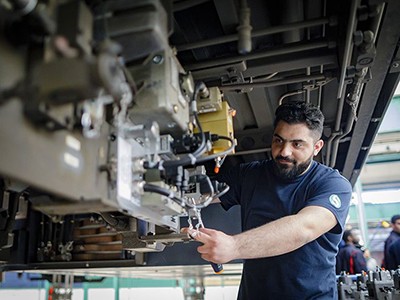Almost every country with a significant science base is home to researchers who have immigrated there. The reasons are many: from fleeing war or persecution to simply seeking better opportunities to pursue scientific work. My father, a Palestinian refugee, was one such researcher. After being expelled by force from Jerusalem to Lebanon in 1948, he moved to the United States in 1969 to complete his medical residency as an immunologist at the University of Iowa in Iowa City. I am one, too. I left Jordan in 2000, to earn my PhD in molecular biology at the University of Iowa.
Scientists and other specialists leaving low- and middle-income countries (LMICs) is so common that the phenomenon has a name: brain drain. Migration induced by climate change is expected to further increase this flow.
But émigré researchers can become a resource for their countries of origin, if given the opportunity. Global and national scientific communities should encourage the opposite of brain drain: brain circulation, in which scientists in diaspora return to their home countries or send back new ideas and expertise.

Migrants and refugees are good for economies
Again, I speak from personal experience. My father travelled to Jordan in 1977, where he established the first department for internal medicine at the University of Jordan in Amman. In 2005, I also returned to Jordan, where I set up a state-of-the-art research laboratory in molecular biology and an award-winning mentoring programme for female scientists.
Some countries, such as India and China, already have significant programmes to encourage researchers to return. For example, in June, the Indian government launched the Vaishvik Bhartiya Vaigyanik programme, which provides fellowships to Indian scientists in diaspora who collaborate with Indian institutions and spend one to two months in India each year.
But brain circulation needs to become more widespread and more systematic, and it must be built from the bottom up. As president of the Society for the Advancement of Science and Technology in the Arab World (SASTA), I organized the Global Conference for Diaspora Networks in Science, hosted online last September, and attended the Global Diaspora Summit in Dublin in April 2022, arranged by the International Organization for Migration, a United Nations agency. At these events, three lessons emerged for existing and future diaspora networks.
First, build member-driven, bottom-up networks. Ideally, each diaspora network should connect with the government, scientific agencies, national academy and scientific community in its home country. But when networks are too top-down and bureaucratic, they often set up frustrating expectations that are unrealistic or unsustainable for the researchers they are trying to connect — for example, around access to funding or collaborations.
My experience suggests that member-driven networks are a promising alternative. At SASTA, we have learnt from successful member-led networks such as Catalyst2030, a global group dedicated to achieving the UN Sustainable Development Goals, and the Global Young Academy, a non-profit organization in Halle, Germany, that connects young scientists. Although these groups are not diaspora-focused, they have flat organizational structures and are member-driven: each participant contributes in a way that is aligned with their own goals.

How three refugee scientists kept their research hopes alive
Second, involve young people. At the Hashemite University in Zarqa, Jordan, a group of students led by medical student Ahmad Jadallah got together in 2014 to promote science awareness and good science practice and research in the country. I was their mentor. They reached out to scientists in diaspora from the Arab world, inviting them to share their personal stories of failure and leadership, mentor students and collaborate on projects.
This grew into a country-wide and then a regional movement called Phi. In eight years, Phi’s platform of courses, taught by scientists in diaspora, has educated more than 5,000 students through 30 cutting-edge courses in future technology, and has spawned the bioinformatics company Bionl, based in Boston, Massachusetts. All this was done in an unofficial manner, not by universities or governments.
Third, build networks of networks. Members of one network can learn from others. The Global Diaspora Summit yielded the idea of creating a network open to female scientists from LMICs who are in diaspora. This would complement the existing Organization for Women in Science for the Developing World, of which I am the president of the Jordan chapter. Participants in the summit also created a virtual community on Lounjee, an app for professional networks, to serve as meta-network to connect diaspora science networks around the world. This will allow lessons from different efforts and groups to be captured and shared.
Tackling climate change and other great challenges requires collaboration across disciplines, cultures, ethnicities, religions and geographies, joining many perspectives and fostering creativity and innovation. For émigré scientists, diaspora networks can also become essential lifelines of moral and mental support during difficult times, especially when institutional backing is scant. By supporting scientists in diaspora and connecting them to their home countries, we can enrich the world and its science — and we have a framework to do it.
